最新英语人教版七年级上册unit4知识点总结
人教版英语七年级上册Unit4知识点
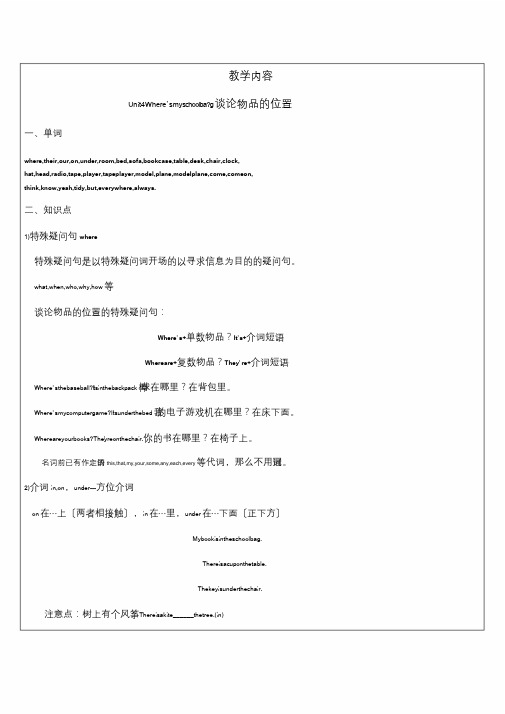
教学内容Unit4Where’smyschool b a?g谈论物品的位置一、单词where,their,our,on,under,room,bed,sofa,bookcase,table,desk,chair,clock,hat,head,radio,tape,player,tapeplayer,model,plane,modelplane,come,comeon,think,know,yeah,tidy,but,everywhere,always.二、知识点1)特殊疑问句where特殊疑问句是以特殊疑问词开场的以寻求信息为目的的疑问句。
what,when,who,why,how等谈论物品的位置的特殊疑问句:Where’s+单数物品?It’s+介词短语。
Whereare+复数物品?They’re+介词短语。
Where’sthebaseball?I’t sinthebackpack棒.球在哪里?在背包里。
Where’smycomputergame?I’t sunderthebed我.的电子游戏机在哪里?在床下面。
Whereareyourbooks?The’y reonthechair.你的书在哪里?在椅子上。
名词前已有作定语的this,that,my,your,some,any,each,every等代词,那么不用冠词。
2)介词in,on,under---方位介词on在⋯上〔两者相接触〕,in在⋯里,under在⋯下面〔正下方〕Mybookisintheschoolbag.Thereisacuponthetable.Thekeyisunderthechair.注意点:树上有个风筝。
Thereisakite______thetree.(in)树上有个苹果。
Thereisanapple______thetree.(on,树上长的、结的)墙上有副画。
Thereisapicture______thewall.(on)墙上有扇窗户。
七年级上册英语unit4知识点人教版
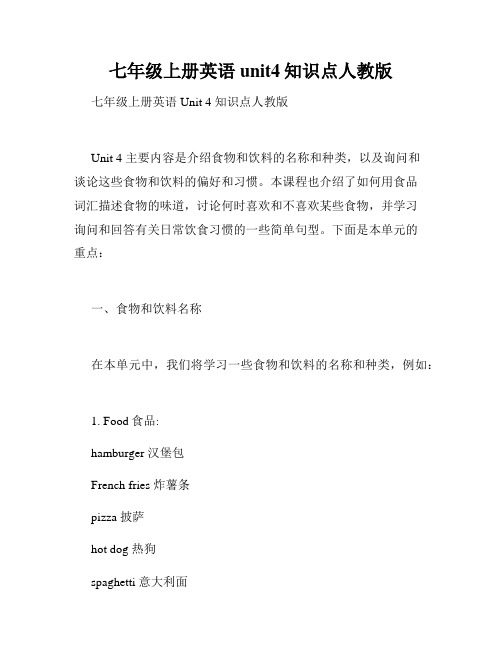
七年级上册英语unit4知识点人教版七年级上册英语Unit 4 知识点人教版Unit 4 主要内容是介绍食物和饮料的名称和种类,以及询问和谈论这些食物和饮料的偏好和习惯。
本课程也介绍了如何用食品词汇描述食物的味道,讨论何时喜欢和不喜欢某些食物,并学习询问和回答有关日常饮食习惯的一些简单句型。
下面是本单元的重点:一、食物和饮料名称在本单元中,我们将学习一些食物和饮料的名称和种类,例如:1. Food食品:hamburger 汉堡包French fries 炸薯条pizza 披萨hot dog 热狗spaghetti 意大利面chicken wings 鸡翅2. Drinks饮料:water 水juice 果汁milk 牛奶tea 茶soda 苏打水coffee 咖啡二、描述食品味道在本单元中,我们将学习如何用食品词汇和形容词来描述食品的味道。
例如:1. Taste口味:sweet 甜的sour 酸的spicy 辣的salty 咸的bitter 苦的2. Texture质地:crispy 酥脆的chewy 嚼劲十足的tender嫩的soft 柔软的hard 坚硬的三、更多有关食品和饮料的句型和表达除了上面的词汇和描述外,还有更多有关食品和饮料的句型和表达必须了解。
例如:1. Do you like…?你喜欢……吗?Do you like pizza?你喜欢披萨吗?2. What’s your favourite…?你最喜欢的是……What’s your favourite food?你最喜欢的食物是什么?3. I like…我喜欢……I like chicken wings.我喜欢鸡翅。
4. I don’t like…我不喜欢……I don’t like spicy food.我不喜欢辣的食物。
5. How about you?你呢?I like hamburgers. How about you?我喜欢汉堡包,你呢?6. Can I have some…?我可以要一些……吗?Can I have some water?我可以要一些水吗?本单元的这些内容都是学生学习英语的基本知识。
人教版初中英语初一上册Unit4 知识点总结与练习
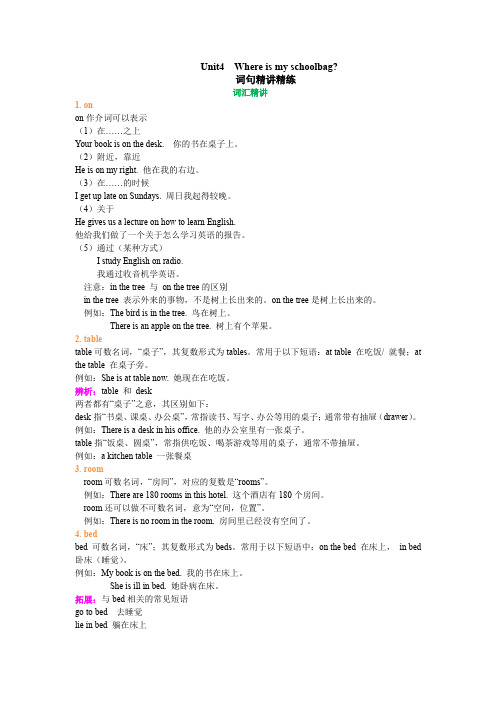
Unit4 Where is my schoolbag?词句精讲精练词汇精讲1. onon作介词可以表示(1)在……之上Your book is on the desk. 你的书在桌子上。
(2)附近,靠近He is on my right. 他在我的右边。
(3)在……的时候I get up late on Sundays. 周日我起得较晚。
(4)关于He gives us a lecture on how to learn English.他给我们做了一个关于怎么学习英语的报告。
(5)通过(某种方式)I study English on radio.我通过收音机学英语。
注意:in the tree 与on the tree的区别in the tree 表示外来的事物,不是树上长出来的。
on the tree是树上长出来的。
例如:The bird is in the tree. 鸟在树上。
There is an apple on the tree. 树上有个苹果。
2. tabletable可数名词,“桌子”,其复数形式为tables。
常用于以下短语:at table 在吃饭/ 就餐;at the table 在桌子旁。
例如:She is at table now. 她现在在吃饭。
辨析:table 和desk两者都有“桌子”之意,其区别如下:desk指“书桌、课桌、办公桌”,常指读书、写字、办公等用的桌子;通常带有抽屉(drawer)。
例如:There is a desk in his office. 他的办公室里有一张桌子。
table指“饭桌、圆桌”,常指供吃饭、喝茶游戏等用的桌子,通常不带抽屉。
例如:a kitchen table 一张餐桌3. roomroom可数名词,“房间”,对应的复数是“rooms”。
例如:There are 180 rooms in this hotel. 这个酒店有180个房间。
人教版七年级英语上册unit 4 句子讲解及知识点梳理
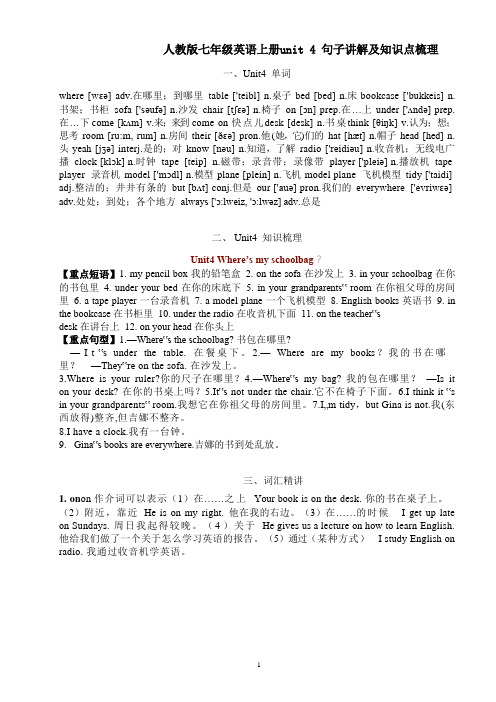
人教版七年级英语上册unit 4 句子讲解及知识点梳理一、Unit4 单词where [wɛə] adv.在哪里;到哪里table ['teibl] n.桌子bed [bed] n.床bookcase ['bukkeis] n. 书架;书柜sofa ['səufə] n.沙发chair [tʃɛə] n.椅子on [ɔn] prep.在…上under ['ʌndə] prep. 在…下come [kʌm] v.来;来到come on 快点儿desk [desk] n.书桌think [θiŋk] v.认为;想;思考room [ru:m, rum] n.房间their [ðɛə] pron.他(她,它)们的hat [hæt] n.帽子head [hed] n. 头yeah [jʒə] interj.是的;对know [nəu] n.知道,了解radio ['reidiəu] n.收音机;无线电广播clock [klɔk] n.时钟tape [teip] n.磁带;录音带;录像带player ['pleiə] n.播放机tape player 录音机model ['mɔdl] n.模型plane [plein] n.飞机model plane 飞机模型tidy ['taidi] adj.整洁的;井井有条的but [bʌt] conj.但是our ['auə] pron.我们的everywhere ['evriwɛə] adv.处处;到处;各个地方always ['ɔ:lweiz, 'ɔ:lwəz] adv.总是二、 Unit4 知识梳理Unit4 Where’s my schoolbag?【重点短语】1. my pencil box 我的铅笔盒 2. on the sofa 在沙发上 3. in your schoolbag 在你的书包里4. under your bed 在你的床底下 5. in your grandparents‟ room 在你祖父母的房间里 6. a tape player 一台录音机7. a model plane 一个飞机模型8. English books 英语书9. in the bookcase 在书柜里10. under the radio 在收音机下面11. on the teacher‟sdesk 在讲台上12. on your head 在你头上【重点句型】1.—Where‟s the schoolbag? 书包在哪里?—I t ‟s under the table. 在餐桌下。
最全面人教版七年级上册英语第四单元知识点归纳总结

Unit 4 Where's my schoolbag?一、词汇与短语● 重点单词A部分1.where adv. 在哪里;到哪里2.table n. 桌子3.bed n. 床4.room n. 房间5.sofa n. 沙发6.their pron. 他(她、它)们的7.chair n. 椅子8.hat n. 帽子9.on prep. 在……上10.head n. 头11.under prep. 在……下12.know v. 知道;了解e v. 来;来到14.bookcase n. 书架;书柜15.desk n. 书桌16.yeah interj. 是的;对17.think v. 认为;想;思考B部分1.radio n. 收音机;无线电广播2.tidy adj. 整洁的;井井有条的3.clock n. 时钟4.but conj. 但是5.tape n. 磁带;录音带;录像带6.our pron. 我们的7.player n. 播放机8.everywhere adv. 处处;到处;各个地方9.model n. 模型10.always adv. 总是11.plane n. 飞机● 重点短语A部分1.on the sofa 在沙发上2.in your schoolbag 在你的书包里3.under your bed 在你的床上e on 快点儿5.on their bed 在他们的床上6.on your head 在你的头上7.under the chair 在椅子下面8.on the sofa在沙发上9.grandparents' room (外)祖父母的房间B部分1.a tape player 一个磁带播放机2.a model plane 一个飞机模型3.under the radio 在收音机下面4.in the bookcase 在书柜里5.on the teacher's desk 在老师的讲桌上6.on the desk 在书桌上7.under the desk 在书桌下8.in my room 在我的房间里● 重点句子A部分1.--Are the keys on the sofa? --No, they aren't. They are on the table.钥匙是在沙发上吗? 不,不是。
人教版英语七年级上册Unit4知识点总结
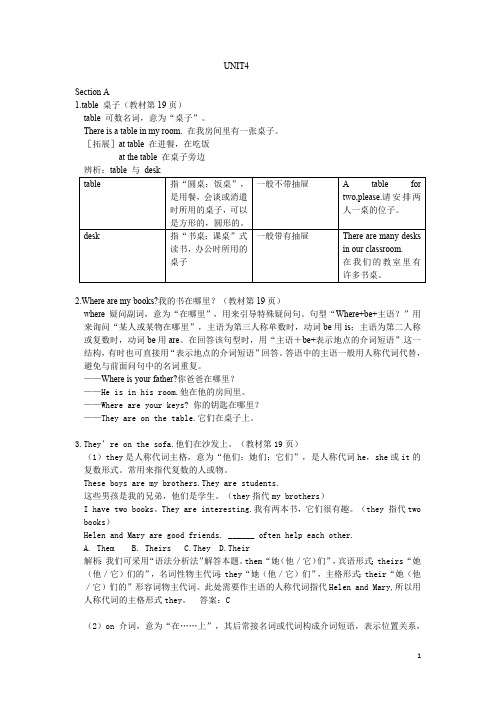
强调一物在另一物的表面上,且两物体有接触面。
The pictures are on the wall.图画在墙上。
(3)sofa名词,意为“沙发”,是一个根据英语读音而翻译出来的音译词。
[拓展]英语中常见的音译词还有jeep 吉普车 cartoon 卡通chocolate 巧克力 coffee 咖啡4.It’s under your bed.它在你的床下面。
(教材第19页)(1)under介词,意为“在……下”,其后常接名词或代词构成介词短语,表示位置关系,通常用于指位于某物的正下方,且两物体不接触。
The car is under the tree.这辆小汽车在树下面。
My shoes are under the bed.我的鞋子在床下面。
[拓展]bedroom卧室 go to bed 上床睡觉make the bed 整理床铺e on,Jack!快点儿,杰克!(教材第20页)(1)come on此处表示催促,意为“赶快,快点儿”。
英语中还可以用Hurry up!表示催促。
Come on.It’s dark.快点儿,天黑了。
[拓展]come on 的其他含义1)用来表示请求,鼓励,劝说等,意为“来吧;行啦。
”。
Come on,Kate.Don’t be shy.来吧,凯特。
别害羞。
2)用来体育竞赛等场合鼓励队员,意为“加油”。
“Come on! Come on!” shouted the students.“加油!加油!”学生大声喊道。
3)用于挑战和激怒对方,意为“来吧;好吧;试试吧”。
Come on!I’m not afraid od you.来吧!我不怕你。
4)用于招呼别人,意为“来,过来”。
Come on!This way,please.来,请走这边。
(2)come 作不及物动词,意为“来;来到”,反义词为go,意为“去”。
Come to my house this Sunday,please.这个星期天请来我家。
七年级上册英语人教版unit4知识点
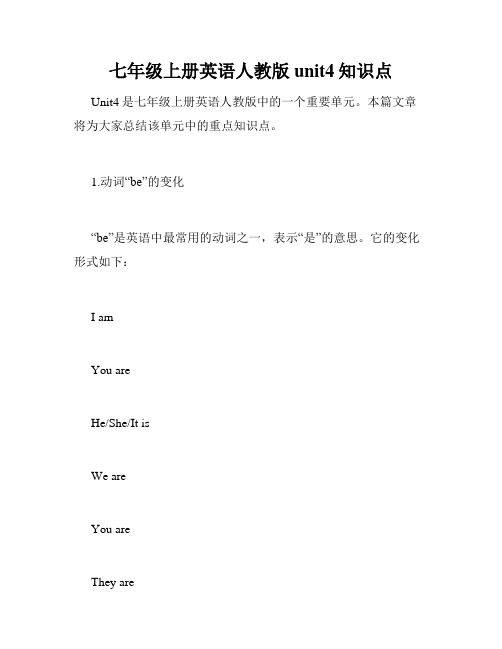
七年级上册英语人教版unit4知识点Unit4是七年级上册英语人教版中的一个重要单元。
本篇文章将为大家总结该单元中的重点知识点。
1.动词“be”的变化“be”是英语中最常用的动词之一,表示“是”的意思。
它的变化形式如下:I amYou areHe/She/It isWe areYou areThey are2.时间表达在英语中,表示时间有两种方式,一种是使用数字,如“2:30”,另一种是使用口语表述,如“half past two”。
下面是表示时间的表达方式:数字表达方式:2:00——two o'clock3:15——quarter past three4:45——quarter to five5:30——half past five口语表达方式:2:00——two o'clock3:15——quarter past three4:45——quarter to five5:30——half past five3.一般现在时一般现在时用来表示现在的状态或行为。
具体用法如下:主语 + 动词原形(第三人称单数动词在末尾加-s/es)例如:I like ice cream.She watches TV every night.They play football after school.4.形容词比较级和最高级形容词比较级和最高级用来进行比较。
比较级表示两个事物之间的比较,最高级表示三个或三个以上事物之间的比较。
下面是比较级和最高级的形式:形容词比较级:单音节词 + er例如:big——biggerthin——thinner双音节词或多音节词 + more例如:interesting ——more interesting difficult——more difficult形容词最高级:单音节词 + est例如:big——biggest thin——thinnest双音节词或多音节词 + the most 例如:interesting——the most interestingdifficult——the most difficult5.物品价格询问和回答询问价格通常用句型“How much is/are + 名词?”回答价格时用句型“It is + 数字 + 美元/元”。
Unit4知识归纳人教版英语七年级上册(1)

Unit 4 知识归纳短语归纳:1.on the sofa在沙发上2.in the bookcase 在书柜里面3.under the chair 在椅子下面4.on one’s bed/head/desk 在某人的床上/头上/书桌上(on Peter’s head 在皮特的头上/ on my bed 在我的床上)5.in one’s schoolbag/room 在书包里6.under one’s bed 在床底下7.e on 快点8.be tidy 整洁的9.tape player 录音机10.model plane飞机模型11.have a clock有一个时钟必背典句:1.Where is + 单数名词?.......在哪里?It’s in/on/under.......... 它在......里面/上面/下面。
Where are + 复数名词?.....在哪里?They are in/on/under...... 它们在.......里面/上面/下面。
( Where is my pencil box?我的铅笔盒在哪?It's under your bed. 它在你的床底下。
)( Where are my books? 我的书在哪?They are in the bookcase. 它们在这个书柜里。
)2. e on, Jack. 快点儿,杰克。
3. I think it’s in your grandparents’ room.我认为它在你(外)祖父母的房间里。
4.I don’t know. 我不知道。
5.Sb. always do/does sth. 某人总是做某事。
(Gina always asks “Where’s my schoolbag?”)(He always says sorry. 他总是说对不起。
)6.Sb/Sth. be tidy. 某人/某物是整洁的。
( I’m tidy. 我是整洁的。
最新人教版七年级英语上册Unit4短语、句型、知识点总结
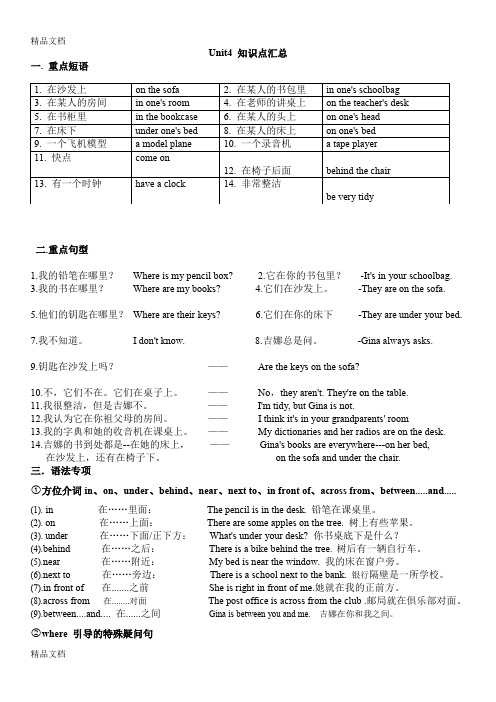
Unit4 知识点汇总一.重点短语1. 在沙发上on the sofa2. 在某人的书包里in one's schoolbag3. 在某人的房间in one's room4. 在老师的讲桌上on the teacher's desk5. 在书柜里in the bookcase6. 在某人的头上on one's head7. 在床下under one's bed 8. 在某人的床上on one's bed9. 一个飞机模型 a model plane 10. 一个录音机 a tape player11. 快点come on12. 在椅子后面behind the chair13. 有一个时钟have a clock 14. 非常整洁be very tidy二.重点句型1.我的铅笔在哪里?Where is my pencil box?2.它在你的书包里?-It's in your schoolbag.3.我的书在哪里?Where are my books?4.它们在沙发上。
-They are on the sofa.5.他们的钥匙在哪里?Where are their keys?6.它们在你的床下-They are under your bed.7.我不知道。
I don't know.8.吉娜总是问。
-Gina always asks.9.钥匙在沙发上吗?——Are the keys on the sofa?10.不,它们不在。
它们在桌子上。
——No,they aren't. They're on the table.11.我很整洁,但是吉娜不。
——I'm tidy, but Gina is not.12.我认为它在你祖父母的房间。
——I think it's in your grandparents' room13.我的字典和她的收音机在课桌上。
(完整版)人教版七年级上册英语知识点全第四单元unit4知识点

(完整版)⼈教版七年级上册英语知识点全第四单元unit4知识点Unit4重点词汇:where、table、bed、bookcase、sofa、chair、on、under、come、desk、tidy、always...1、重点短语:on the sofa 在沙发上 on the table 在桌上on your head 在你的头上 under the chair在椅⼦下under the bed 在床下 under the table 在桌下in your schoolbag 在你的书包⾥ in the bookcase 在书柜⾥in your grandparents’ room 在你爷爷奶奶的房间⾥come on 快点2、where引导的特殊疑问句,⽤于询问“某⼈或某物在哪⾥”,若谓语动词为be动词,其结构为“Where + be + 主语?”,be动词要与后⾯的主语保持⼀致。
其答语,⽤“主语+be+表⽰地点的的介词短语”为避免重复,句中的主语⼀般⽤代词代替。
----Where is/are...?----It’s/They’re on /in/under...----Where is my English book?----It’s on the desk.1)My clock is on the table?(就画线部分提问)________ ________ your clock?2)你的爸爸在哪?(翻译下列句⼦)______________________________________________3、on 在……的上⾯(接触) on the sofa/desk/table/bed on the tree 在树上(本⾝固有的)in 在……的⾥⾯ in your schoolbag/room in the tree 在树上(外来的事物)under 在……的下⾯(正下⽅) under your bed/desk若表⽰“某物在某地”则⽤“物 + be + 介词短语”结构。
Unit4知识点人教版英语七年级上册

Section A1. boring (P44 1c)( ) His speech makes every one of us .A.bored; boredB. boring; boringC. boring; boredD. bored; boringC2. useful (P441c)a useful bookuseless adj.3. exciting .) (P44 1c)excited a. ” excitement n.“( ) How it is to take a trip to the park with my classmates!A. excitingB. usefulC. uselessD. dangerousA4. learn (v.) (P45 2a)(1). learn…from…/lea rn from…“(2). learn to do sth. ”(3). learn about “(4). learn by oneself =teach oneself “learn & study5. past (P45 2a)(adv.)(prep.)(1). in the past few weeks(2). in the past(3). half past seven ”(4). go/walk past =pass ”6. good(P45 2a)be good at/for/to/with() Doing eye exercisesisyour health.A. good toB. good oC.good at D. goodforD7. help&(P45 2a)(1)ask for help ”need some help “”with one ’s help =with the help of(2)help sb. (to) do sth.”help sb. with sth. ”help oneself to sth.…”help (sb.) out( ) 1. —Are you feeling any better now?—No. I have taken some medicine, but it just d oesn’t . A. use B. care C. help D. fitC( ) 2.Would you my Chemistry?Yes, I’d love to.A. help forB. help inC. help withD. help toC8. listen “(P47 3b)(1). listen to sb. /sth. “. . . . . .”(2). listenListen! They are watching the TV show. ”( ) 1. Listen! Our teacher in the music classroom .A. singsB. sangC. will singD. is singingD( ) 2. —Jim, could you please answer the question?—Sorry, I . Could you say it again?A.wasn’t listeningB. don’t listenC. am not listeningD. won’t listenA9. remember (P473c)(1) remember to do(2) remember doing( ) 1. Remember me when you arrive!A. callB. to callC. callingD. calledB( ) 2. Why is the letter still here? I remember it yesterday.A. postB. to postingC. postingD. postedCSection B1. French .) (P48 1b)Frenchman p l. Frenchmen)2. future (P48 1b)in the future3. work (P48 1b)(1). work hard = be hardworking ”(2). work on(3).work for ......”(4). work out e.g. work it out(5). at work ”( ) 1. My aunt is working a teacher.A. asB. forC.D. outA2.My uncle has worked really hard,so he succeeded at last.My uncle succeeded at last because of his .hard work4. life p l. lives) (P48 1b)(1). save one ’s life”(2). in one ’s life”(3). lead/live a happy life语法聚焦a nd,but becauseI..( ) 1. It’s hard fo r us to say goodbye we have so manyhappy daysto remember.A. soB. becauseC. althoD. butB( ) 2. I like dancing, I don’t have enough time to practice it.A. orB. soC. butD. becauseC( ) 3. Chen Wei isn’t at school today he is taking a robot petitionin Shanghai.A. soB. becauseC. beforeD. ifBin, on a t(1) atat :at six twenty,at midnight,at the moment(2) ina. in 2017, in May, in spring,in themorning/afternoon/evening, in ten yearsb. They will e back in a week.(3) ona. on Monday ,on May 4thb. m orning, afternoon, evening, night on themorning of July 6on a rainy morning, on Tuesday morning, on a cold night。
人教版初中英语七年级上册Unit4基础知识讲解

人教新目标英语七年级上册Unit 4 Where’s my schoolbag?重点单词和短语1.table 桌子table 可数名词,意为“桌子”There is a table in my room. 在我房间里有一张桌子。
【拓展】at table 在进餐,在吃饭at the table 在桌子旁边辨析:table与desktable 指“圆桌;饭桌”是用餐、会谈或消遣时所用的桌子A table for two, please . 请安排两人一桌的位子。
desk指“书桌;课桌”是读书、办公时所用的桌子There are many desks in our classroom . 在我们的教室里有许多书桌。
2. under介词,意为“在....下”其后常接名词或代词构成介词短语,表示位置关系,通常用于指处于某物的正下方,且两物体不接触。
The car is under the tree. 这辆小汽车在树下面。
My shoes are under the bed. 我的鞋子在床下面。
3.bed 可数名词,意为“床”There are two beds in my bedroom. 在我的卧室有两张床.【拓展】bedroom 卧室go to bed 上床睡觉make the bed 整理床铺4. come on 此处表示催促,意为“赶快;快点儿”英语中还可用Hurry (up)! 表示催促。
Come on, it’s dark. 快点儿,天黑了。
【拓展】come on的其他含义:①. 用来表示请求、鼓励、劝说等,意为“来吧;行啦”。
Come on, Kate. Don’t be shy. 来吧,凯特。
别害羞。
②.用于体育竞赛等场合鼓励队员,意为“加油”“Come on! Come on! ”shouted the students. “加油!加油!”学生们大声喊道。
③. 用于挑战或激怒对方,意为“来吧;好吧;试试吧”。
新人教版七年级(上册)Unit 4 知识点总结

新人教版七年级(上册)Unit 4 知识点总结nit 4 My Favourite Subject一、短语归纳1. the importance of ……..的重要性2. favourite subject 最喜欢的学科3. wake up 醒来4. be late for 迟到5. come on 快点6. next class 下一节课7. learn about 了解;学习;知道8. be good with 灵巧的;善于应付…的9. help sb with 帮助某人做(某事)10. look at sth 看某物11. let sb do sth 让:果人做某事12. listen to 听;倾听13. be good at 擅长14. walk to school 步行去卜:学15. work hard 努力工作16. make sb /sth+adj. 计果人 /物17. make sb do sth 让某人做果事18. on that day 在那天19. the same as 与……一样20. all kinds of 各种各样的21. want to be 想要成为22. in the future 将来;未来23. work out 计算出;解决24. in class 课堂上25. feel like 感觉像26. in one's life 在某人的生活中二、必背重点句型1. 谈论最喜欢的学科:——What's your favourite subject?你最喜欢的学科是什么?——My favourite subject is English.我最喜欢的学科是英语。
2. 询问原因并给出理由:-——Why do you like it?你为什么喜欢它?——It's interesting to learn about the past. 了解过去是有趣的。
人教版英语七年级上册单元知识点Unit 4 知识点

Unit 4 Where's my schoolbag?知识点:1.重点单词:room, table, bed, sofa, chair, desk, radio, clock, tape, tape player, model plane, on, under, where, their2. 短语归纳:on the sofa 在沙发上in the schoolbag 在书包里under the bed 在床底下come on 快点be tidy 整洁的tape player 录音机model plane 飞机模型have a clock 有一个时钟3. 必背典句:1. Where is my pencil box? 我的铅笔盒在哪?2. Where are my books? 我的书在哪?3. It’s under your bed. 它在你的床底下。
4. Come on, Jack. 快点儿,杰克。
5. I think it’s in your grandparents’ room. 我认为它在你(外)祖父母的房间里。
6. I don’t know. 我不知道。
7. I’m tidy. 我是爱整洁的人。
4. 语法知识:(1)Where引导的特殊疑问句含义:询问人或者物品所在的位置。
句式:where +be+名词?答语句式:It is ...;They are... it is或they are可省。
(2)I think的用法变否定句:I don’t think it’s in your grandparents’ room.宾语从句表示否定意义,在形式上应该否定前面的主句。
人教版七年级上册英语Unit4知识点梳理及语法讲义(学生版)

七年级上册英语Unit 4知识点与语法精讲精练词汇梳理(一)完成单词梳理:名词:1. 桌子 2. 床 3. 书架;书柜4. 沙发5. 椅子6. 书桌7. 房间8. 帽子9. 头10. 收音机11. 时钟12. 磁带;录音带13. 播放机14. 模型15. 飞机动词:1. 来;来到 2. 认为;想;思考 3. 知道;了解代词:1. 他(她、它)们的 2. 我们的介词:1. 在……上 2. 在……下副词:1. 在哪里;到哪里 2. 处处;到处;各个地方3. 总是连词:1. 但是形容词:1. 整洁的;井井有条的感叹词:1. 是的;对(二) 词汇变形小结:1. they (人称代词主格:他/她/它们) — (人称代词宾格) — (形容词性物主代词:他/她/它们的) — (名词性物主代词:他/她/它们的)2. tidy (adj. 整洁的) — (反义词:不整洁的)3. radio (n. 收音机) — (复数)4. we(人称代词主格:我们) — (人称代词宾格) — (形容词性物主代词:我们的) — (名词性物主代词:我们的)【练一练】用所给词的适当形式填空1.Look! Those are four (bed) in my house.rry and I are Bill’s daughters, so Bill is(we) father.3.Those old CD( player) are very nice.4.Susan and Emma thank(they) teacher for helping them find the keys.5.Tina (e) to the gym and plays sports.6.These (room) are too small.7.Look! Your model plane (be) on the sofa.8.The Chinese book is (he).9.Look at my (mother) room. It’s very clean.10.These are (they) baseballs.(三) 短语攻关:快点儿磁带播放机飞机模型在沙发上在某人的书包里在某人的床下面在某人的头上讲桌铅笔盒电脑游戏知识点梳理1. Where are my books? 我的书在哪里?【用法详解】“Where+be动词+主语?”该句型为where引导的特殊疑问句,用来询问“某人或某物在哪里?”。
- 1、下载文档前请自行甄别文档内容的完整性,平台不提供额外的编辑、内容补充、找答案等附加服务。
- 2、"仅部分预览"的文档,不可在线预览部分如存在完整性等问题,可反馈申请退款(可完整预览的文档不适用该条件!)。
- 3、如文档侵犯您的权益,请联系客服反馈,我们会尽快为您处理(人工客服工作时间:9:00-18:30)。
最新英语人教版七年级上册unit4知识点总结Unit 4 Where’s my school bag? 知识点复习重点句子解析1.Where is my computer game?我的电脑游戏在哪里?①Where 是一个疑问副词,对地点进行提问。
引导一个特殊疑问句。
②特殊疑问句的构成是特殊疑问词+一般疑问句。
如,There is abook on the table.对划线部分提问:______________________.③computer game 电脑游戏,一台电脑游戏是a computer game,注意与play computer games这个短语区分。
回答的时候用It’s…2. Are the keys on the sofa? 钥匙在沙发上吗?这是一个一般疑问句。
注意the keys做主语谓语动词用复数,a set of keys做主语谓语动词用单数。
on the sofa为固定搭配,在沙发上。
e on, Jack.快点,杰克。
此处,come on为固定短语,意为“赶快,快点”表催促。
相当于Hurry up! 例句:Come on, David. We don’t have enough time.此外,come on 还有加油的含义。
4.I think it’s in your grandparents’room.我认为它在你祖父母的房间里。
①think 后面是一个宾语从句。
注意,think引导宾语从句时,要否定前移。
例如,不能说I think it’s not in your grandparents’ room.而要说,I don’t think it’s in your grandparents’ room.②在某个房间里,要用介词in.例如,in this room.③grandparents’是名词所有格形式。
以s结尾的名词变所有格直接5.It’s on their bed.在他们的床上。
①物品在床上,要用介词on。
固定搭配,on the bed.②躺在床上,in bed,注意此处没有定冠词the.例如,sleep in bed.③相关词组:make the bed/make one’s bed; make tea/ make dumplings.④拓展:make 的用法。
make sb. do sth. make sb. adj. 例句:I make him cry, I am sorry for that. She always makes me laugh.I make my mum happy every day.6.I don’t know.我不知道。
7.The notebook is under the model plane in the bookcase.笔记本在书柜里的模型飞机下面。
①笔记本note和book不要拆开。
类似的还有schoolbag。
②注意此句子的句子成分。
③在书柜里,固定搭配,in the bookcase.8.I am tidy, but Gina is not.我整洁,但是吉娜却不。
① tidy的用法见词汇解析。
②在这个句子中,but表示转折。
But后的句子是一个省略句,省略了tidy。
9. Gina’s books are everywhere----on her bed, on the sofa and under the chair. 吉娜的书到处都是,在她的床上,沙发上,地板上。
Everywhere 是一个副词,意为到处、处处、各个地方。
补充例句:I look for him everywhere.由于她的书到处都是,所以不能是一本书,所以句中用了books一10. The white model plane is hers. 这个白色的模型飞机是她的。
注意模型飞机这个短语中model是作定语的,它位于所修饰名词plane 之前。
hers是名词性物主代词,可以独立使用。
联想:名词性物主代词和形容词性物主代词的区别。
11.Gina always asks.吉娜总是问。
Always是副词,用语助动词、系动词、情态动词之后,实意动词之前。
由于Gina 是第三人称单数,做主语谓语动词发生变化,既asks,不受always的影响。
重点词汇解析1. bed c.床bedsgo to bed 上床睡觉make the bed 整理床铺东西在床上on the bed Some books are on the bed.躺在床上in bed sleep in bedDon’t read in bed.2. think 想、认为、思考Where’s the map? I think it’s in your parents’ room.I think so. 我想是这样。
I don’t think so. 我不这样认为注意要否定前移3. their 他们的形容词性物主代词theirs 名词性物主代词Are these books theirs. Yes, they are. No, they aren’t.Their balls are on the sofa.主格they 宾格themThey like me. I like them.You and I like them. They like you and me.4. know 知道,了解同音词noI know you’re a teacher.Who knows? I know. I don’t know.5. radio 收音机[c] radiosradio photo video bamboo piano + snegro hero potato tomato + esThe English books are under the radio.on the radio = over the radio 用广播、在广播中I listen to music on the radio / over the radio.比较在电视上on TV6. tidy adj. 整洁的,井井有条的a tidy room / desk 整洁的房间/书桌I’m tidy, but Gina is not.最新英语人教版七年级上册Unit4单词重点句型语法解析人教版新目标七年级上 Unit 4 where’s my schoolbag?where 在哪里;到哪里table 桌子bed 床bookcase 书架;书柜 =bookshelf,bookshop 书店 bookmark 书签bookstall书亭,书摊sofa 沙发chair 椅子on 在.......上under 在.......下come 来;来到come on 快点儿desk 书桌think 认为;想;思考room 房间their 他(她、它)们的hat 帽子head 头yeah 是的;对know 知道;了解radio 收音机;无线电广播clock 时钟tape 磁带;录音带;录像带player 播放机tape player 录音机model 模型plane 飞机model plane 飞机模型tidy 整洁的;井井有条的but 但是our 我们的everywhere 处处;到处;各地always 总是1.radio n.收音机;无线电广博listen to the radio 听收音机 on the radio 通过广播/收音机2.clock n. 时钟against the clock 抢时间 alarm clock 闹钟 like clock (如始终一般)准确地o’clock ……点钟(对比clock 表示“钟表”)与watch 的辨析,见七上unit33.tape n.磁带;录音带;录像带tape player 磁带播放机 CD player CD播放机player此处意为“播放机”,为可数名词,还有运动员的意思。
4.plane 飞机model plane 飞机模型 on a plane 在飞机上catch a plane 赶飞机 by plane 乘飞机5.tidy adj.整洁的;井井有条的 v.使……保持整洁;整理;收拾untidy 不整洁的;凌乱的近义词:neat adj.整洁的 clean adj.干净的;v.打扫keep tidy 保持整洁 neat and tidy 干净整齐6.but conj.但是用于连接两个并列的成分,表示前后意义上的转折或两种情况的对比,意为“但是”。
but for…如果没有,要不是…… not…but…不是……而是……(谓语按照就近原则)Not you but he is wrong.不是你而是他错了She is not a student but a worker.她不是学生而是工人。
与and 辨析and 表示对等或顺城关系,意为“和;并且”。
and 详解见七上starter unit1He is poor but very happy. 他很穷但是很快乐。
We study English and French . 我们学习英语和法语。
but 作介词,意为“除……之外”在一定的上下文中表示转折的but常用于以下几种情况:①用于句首,以衔接上文But what else can we do?但是我们还能做什么?②用于委婉的拒绝或道歉。
—May I use your dictionary?我可以用你的字典吗?—I’m sorry,but it’s not here now.对不起但是它现在不在这里—Would you like to help me this afternoon?今天下午你愿意帮我吗?—I’d like to, but I have no time. 我想去,但是我没有时间。
7.everywhere adv. 处处;到处;各个地方every 和where 合成的副词称为合成词。
everywhere = here and theresomewhere 某处(用于肯定句)anywhere 任何地方(用于否定句或疑问句)nowhere 哪里都不everyday 日常的 everybody 每个人 everything 一切事情(every day 每天)8.have v. 拥有第三人称单数形式has9.think v.认为;想;思考形近词:thank①英语中常用think 来表达自己的主观看法或想法,当主语为第一人称时,think后的从句表示否定意义时,要否定主句,而不是否定从句,我们称之为“否定转移”。
但翻译时仍然否定从句。
